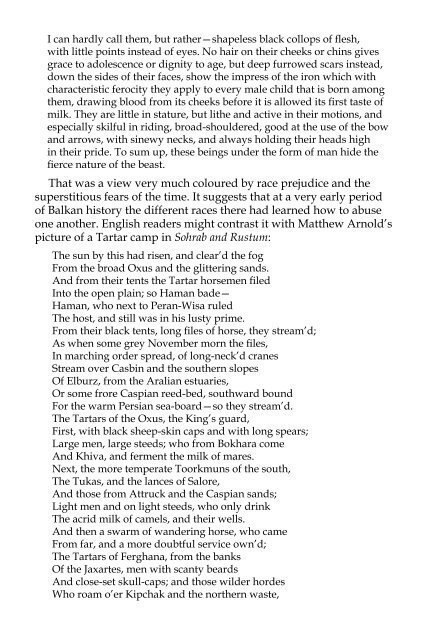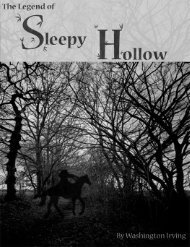Bulgaria e-book - iMedia
Bulgaria e-book - iMedia
Bulgaria e-book - iMedia
You also want an ePaper? Increase the reach of your titles
YUMPU automatically turns print PDFs into web optimized ePapers that Google loves.
I can hardly call them, but rather—shapeless black collops of flesh,<br />
with little points instead of eyes. No hair on their cheeks or chins gives<br />
grace to adolescence or dignity to age, but deep furrowed scars instead,<br />
down the sides of their faces, show the impress of the iron which with<br />
characteristic ferocity they apply to every male child that is born among<br />
them, drawing blood from its cheeks before it is allowed its first taste of<br />
milk. They are little in stature, but lithe and active in their motions, and<br />
especially skilful in riding, broad-shouldered, good at the use of the bow<br />
and arrows, with sinewy necks, and always holding their heads high<br />
in their pride. To sum up, these beings under the form of man hide the<br />
fierce nature of the beast.<br />
That was a view very much coloured by race prejudice and the<br />
superstitious fears of the time. It suggests that at a very early period<br />
of Balkan history the different races there had learned how to abuse<br />
one another. English readers might contrast it with Matthew Arnold’s<br />
picture of a Tartar camp in Sohrab and Rustum:<br />
The sun by this had risen, and clear’d the fog<br />
From the broad Oxus and the glittering sands.<br />
And from their tents the Tartar horsemen filed<br />
Into the open plain; so Haman bade—<br />
Haman, who next to Peran-Wisa ruled<br />
The host, and still was in his lusty prime.<br />
From their black tents, long files of horse, they stream’d;<br />
As when some grey November morn the files,<br />
In marching order spread, of long-neck’d cranes<br />
Stream over Casbin and the southern slopes<br />
Of Elburz, from the Aralian estuaries,<br />
Or some frore Caspian reed-bed, southward bound<br />
For the warm Persian sea-board—so they stream’d.<br />
The Tartars of the Oxus, the King’s guard,<br />
First, with black sheep-skin caps and with long spears;<br />
Large men, large steeds; who from Bokhara come<br />
And Khiva, and ferment the milk of mares.<br />
Next, the more temperate Toorkmuns of the south,<br />
The Tukas, and the lances of Salore,<br />
And those from Attruck and the Caspian sands;<br />
Light men and on light steeds, who only drink<br />
The acrid milk of camels, and their wells.<br />
And then a swarm of wandering horse, who came<br />
From far, and a more doubtful service own’d;<br />
The Tartars of Ferghana, from the banks<br />
Of the Jaxartes, men with scanty beards<br />
And close-set skull-caps; and those wilder hordes<br />
Who roam o’er Kipchak and the northern waste,<br />
Kalmucks and unkempt Kuzzaks, tribes who stray<br />
Nearest the Pole, and wandering Kirghizzes,<br />
Who come on shaggy ponies from Pamere;<br />
These all filed out from camp into the plain.<br />
Matthew Arnold gives to the Tartar camp tents of lattice-work,<br />
thick-piled carpets; to the Tartar leaders woollen coats, sandals,<br />
and the sheep-skin cap which is still the national head-dress of the<br />
<strong>Bulgaria</strong>ns. More important, in proof of his idea of their civilisation,<br />
he credits them with a high sense of chivalry and a faithful regard<br />
for facts. Sohrab and Rustum is, of course, a flight of poetic fancy; but<br />
its “local colour” is founded on good evidence. Probably the Huns,<br />
despite the terrors of their name, the echoes of which still come down<br />
the corridors of time; despite the awful titles which their leaders<br />
won (such as Attila, “the Scourge of God”), were not on a very much<br />
lower plane of civilisation than the Goths with whom they fought,<br />
or with the other barbarians who tore at the prostrate body of the<br />
Roman Empire. One may see people of very much the same type<br />
to-day on the outer edges of Islam in some desert quarters; one may<br />
see and, if one has such taste for the wild and the free in life as has<br />
Cunninghame Graham, one may admire:<br />
There in the Sahara the wild old life, the life in which man and the<br />
animals seem to be nearer to each other than in the countries where<br />
we have changed beasts into meat-producing engines deprived of<br />
individuality, still takes its course, as it has done from immemorial time.<br />
Children respect their parents, wives look at their husbands almost as<br />
gods, and at the tent door elders administer what they imagine justice,<br />
stroking their long white beards, and as impressed with their judicial<br />
functions as if their dirty turbans or ropes of camels’ hair bound round<br />
their heads, were horse-hair wigs, and the torn mat on which they sit<br />
a woolsack or a judge’s bench, with a carved wooden canopy above it,<br />
decked with the royal arms.<br />
Thus, when the blue baft-clad, thin, wiry desert-dweller on his lean<br />
horse or mangy camel comes into a town, the townsmen look on him as<br />
we should look on one of Cromwell’s Ironsides, or on a Highlander, of<br />
those who marched to Derby and set King George’s teeth, in pudding<br />
time, on edge.<br />
The Huns’ movement from the north-east was the first Asiatic<br />
invasion of Europe since the fall of the Persian Empire. Almost<br />
simultaneously with it the Saracen first entered from the south, as the<br />
ally of the Christian Emperor against the Goths; and another Gothic<br />
chronicler, Ammianus, tells how the Saracen warriors inspired also a<br />
lively horror in the Gothic mind. They came into battle almost naked,





